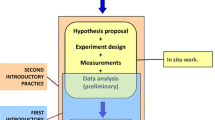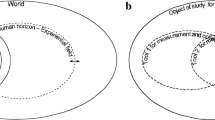Abstract
The present study focuses on the educational value of lab work while teaching and learning Physics. Specifically, it investigates and compares the learning outcomes between three different experimental groups, in the study of the Simple Gravity Pendulum in the lower secondary school, using a sample of 61 students aged 14–15. The first group comprising 25 students practiced first on virtual and then on real lab, while the second group of 24, first on real and then on virtual lab (change of order in the tasks). An additional third group, involving 12 students, used sensors and data loggers during experimental practice. The educationally optimum order of use of such labs is investigated herein. The learners exploited the capabilities of the lab equipment, in that they themselves designed, constructed, and analysed the simple gravity pendulum. The focus in the teaching and learning of the pendulum was on examining subject relevance in the context of everyday applications, the independency of the period from the mass of the bob, or the amplitude, and the dependence of the period from the pendulum length, and the local acceleration of gravity. The research tools used were a stabilised questionnaire, with 16 closed-type questions and 7 questions asking for a justifying answer, in addition to a semi-structured interview. Data were taken and were appropriately analysed and compared, and conclusions are presented herein. The results confirmed that concerning some teaching objectives, learners’ understanding is positively affected by the order the real and the virtual labs are used in teaching. This result applies when addressing this age-group, and when teaching the simple gravity pendulum.
Access this chapter
Tax calculation will be finalised at checkout
Purchases are for personal use only
Similar content being viewed by others
References
Gauld, C.: Pendulums in the physics education literature: a bibliography. In: Matthews, M., Gauld, C., Stinner, A. (eds.) The Pendulum, pp. 505–526. Springer, Netherlands (2005)
Cwudkova, L., Musilova, J.: The pendulum: a stumbling block of secondary school mechanics. Phys. Educ. 35(6), 428–435 (2000)
Galili, I., Sela, D.: Pendulum activities in the physics curriculum: used and missed opportunities. In: Matthews, M.R. (ed.) International Pendulum Project, Conferences Papers, vol. 2, pp. 189–203. The University of New South Wales, Sydney (2002)
Yang, I.-H., Kwon, Y.-J., Jeong, J.-W.: Effects of students’ prior knowledge on scientific reasoning in solving pendulum task. In: Matthews, M.R. (ed.) International Pendulum Project, Conferences Papers, vol. 1, pp. 163–175. The University of New South Wales, Sydney (2002)
Koumaras, P.: Using the pendulum in the education of teachers. In: Matthews, M.R. (ed.) International Pendulum Project, Conferences Papers, vol. 2, pp. 205–219. The University of New South Wales, Sydney (2002)
Dossis, S., Koliopoulos, D.: The problem of timekeeping with the help of the simple pendulum: an empirical study of 14-15-year-old Greek school students. In: Matthews, M. (ed.) 2nd International Pendulum Project, pp. 65–78. University of New South Wales, Sydney (2005)
Dossis, S., Koliopoulos, D.: Comment les élèves du collège conçoivent le mouvement du pendule: une recherche empirique. Skholê, vol. Hors-série, 1, 41–51 (2007)
Sumida, M.: The public understanding of pendulum motion: from 5 to 88 years old. In: Matthews, M., Gauld, C., Stinner, A. (eds.) The Pendulum, pp. 465–484. Springer, Netherlands (2005)
Inhelder, B., Piaget, J.: The Growth of Logical Thinking from Childhood to Adolescence. Routledge and Kegan Paul, London (1958)
Gil Perez, D., Carrascosa, J.: Science learning as a conceptual and methodological change. Eur. J. Sci. Educ. 7(3), 231–236 (1985)
Bond, G.T.: Piaget and the pendulum. In: Matthews, M.R. (ed.) International Pendulum Project, Conferences Papers, vol. 1, pp. 121–129. The University of New South Wales, Sydney (2002)
Stafford, E.: What the pendulum can tell educators about children’s scientific reasoning. In: Matthews, M.R. (ed.) International Pendulum Project, Conferences Papers, vol. 2, pp. 145–175. The University of New South Wales, Sydney (2002)
Edwardes, E.: The Story of the Pendulum Clock. John Sherratt & Son, Altrincham (1977)
Drake, S.: The laws of pendulum and fall. In: Drake, S. (ed.) Galileo: Pioneer Scientist. University of Toronto Press, Toronto (1990)
Drake, S.: Galileo at Work. Dover Publications, New York (1996)
Boulos, P.: Newton’s path to universal gravitation: the role of the pendulum. In: Matthews, M., Gauld, C., Stinner, A. (eds.) The Pendulum, pp. 151–169. Springer, Netherlands (2005)
Emmerson, A.: Things are seldom what they seem -Christiaan Huygens, the pendulum and the cycloid. In: Matthews, M. (ed.) 2nd International Pendulum Project, pp. 79–130. University of New South Wales, Sydney (2005)
Machamer, P., Hepburn, B.: Galileo and the pendulum: latching on to time. In: Matthews, M., Gauld, C., Stinner, A. (eds.) The Pendulum, pp. 99–113. Springer, Netherlands (2005)
Psillos, D., Niedderer, H.: Issues and questions regarding the effectiveness of labwork. In: Psillos, D., Niedderer, H. (eds.) Teaching and Learning in the Science Laboratory, pp. 20–21. Kluwer Academic Publishers, Netherlands (2002)
Choi, B.S., Gennaro, E.: The effectiveness of using computer simulated experiments on junior high students’ understanding of the volume displacement concept. J. Res. Sci. Teach. 24(6), 539–552 (1987)
Mosterman, P.J.: Student perceptions of learning in the laboratory: comparison of industrially situated virtual laboratories to capstone physical laboratories. J. Eng. Educ. 100(3), 540–573 (1994)
Kocijancic, S., O’Sullivan, C.: Real or virtual laboratories in science teaching – is this actually a dilemma? informatics. Education 3(2), 239–250 (2004)
Wiliam, D.: What is assessment for learning? Stud. Educ. Eval. 37, 3–14 (2011)
Author information
Authors and Affiliations
Corresponding author
Editor information
Editors and Affiliations
Rights and permissions
Copyright information
© 2017 Springer International Publishing AG
About this paper
Cite this paper
Tsihouridis, C., Vavougios, D., Ioannidis, G. (2017). The Effect of Switching the Order of Experimental Teaching in the Study of Simple Gravity Pendulum - A Study with Junior High-School Learners. In: Auer, M., Guralnick, D., Uhomoibhi, J. (eds) Interactive Collaborative Learning. ICL 2016. Advances in Intelligent Systems and Computing, vol 544. Springer, Cham. https://doi.org/10.1007/978-3-319-50337-0_47
Download citation
DOI: https://doi.org/10.1007/978-3-319-50337-0_47
Published:
Publisher Name: Springer, Cham
Print ISBN: 978-3-319-50336-3
Online ISBN: 978-3-319-50337-0
eBook Packages: EngineeringEngineering (R0)




